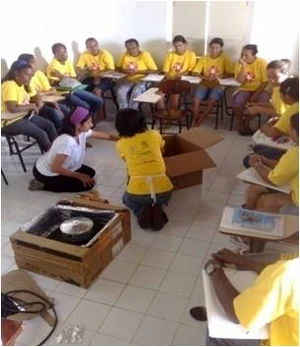- October 2014: Dr. Paulo Araujo reports: We are working hard in parallel to try to transform the university cafeteria (Federal University of Sergipe) serving approximately 1,000 meals daily to 100% solar. We need support from institutions who wish to help us with this project.
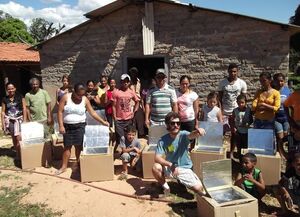
Nicolau Bussolotti Francine of São Paulo, Brazil, and founder of Pleno Sol, is on a tour organizing solar cooker construction workshops.
- June 2014: Nicolau Bussolotti Francine of São Paulo, Brazil, and founder of Pleno Sol, is on a tour around the Natural Reseva of "Port Cashew". He is organizing workshops for building and using inexpensive solar cookers as he travels.
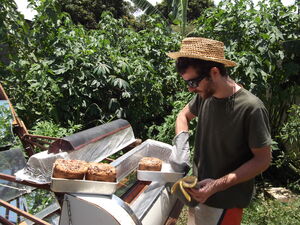
Nicolau with P.S.II.2 (http://plenosol.wordpress.com/fornos-solares/p-s-ii-2/)
- November 2012: Baking with a solar box cooker - In 2010, Nicolau Bussolotti Francine of São Paulo, Brazil, developed a box solar cooker for baking. Francine reports that his model can bake up to one kilo of cookies or 36 muffins at one time. In 2011 he began developing a more powerful bread oven. Using the SCInet wiki, Francine was able to make contact with other solar cooker manufacturers who were using Fresnel lenses. He incorporated multiple plain Fresnel lenses into his new design. His company Plenosol Cozinha Solar has recently filled a large order from an NGO working in the Natural Reserve Serra das Almas.
- November 2012: An experimental solar cooking school has been established by the Energy and Materials Laboratory (LEM) at the Mechanical Engineering School of the Federal University of Sergipe in Brazil. The Project’s Field research is being coordinated in a socially vulnerable community in Brazil by Dr. Paulo Mário Machado Araújo. The Energy and Material Laboratory was founded in 2001. It’s situated in the Mechanical Engineering Department of the Federal University of Sergipe, and is coordinated by the professor Dr. Paulo Mário Machado Araújo. The laboratory works with applied research, focusing on social technologies and trying to improve the quality of life for people living in poor communities. One of LEM´s outstanding projects, the Experimental Solar Kitchen School, was innovational in creating a laboratory in a socially vulnerable community. There it was possible to experience the benefits of solar kitchens to guaranty nutrition, social inclusion, human health and environmental education, as well as the construction of solar ovens, and production of carbon credits. Another project developed at LEM is the SOLAGUA, which studies the disinfection of water using solar energy. A low cost water treatment pilot plant to be used in poor communities was studied, with results measured at 75 liters/day/m2 of water disinfected via solar energy. Other projects with solar energy that are being studied and tested include: dried fruits and vegetables; thermal treatment of concrete for accelerated curing; as well as the production of steam for the development of new solar kitchens or mechanical energy production. One of the most ambitious of LEM’s recent projects is to try to make a solar restaurant at the university, to provide the 1,300 daily student meals. Another challenge is to improve the pilot plant for water disinfection via solar energy. LEM will also promote the development of techniques for the use of low cost materials in solar equipment. Fixed focus solar concentrators are being studied for application in solar kitchens. One objective in particular is to continue teaching how to build and use solar ovens made of cardboard boxes. Governmental institutions have supported some of LEM’s projects, for instance, The Organization of the United Nations for Education, Science and Culture (UNESCO), The Foundation of Research Support and Innovation (FAPITEC), as well as the Secretary of Social Inclusion (SEIDES), the latter two in connection with the State of Sergipe.
- November 2009: Forno solar ganha mercado e se volta para exportações - Lusa
- August 2009: Índios de MS experimentam fogão solar - Povos Indígenas no Brasil
- July 2009: Jose Albano reports that a government-sponsored solar box cooker workshop conducted by Paulo Araujo was featured on a Globo TV national news broadcast.
- November 2008: Report on large project in Brazilia - Solar Cooking Plus
- March 2007: José Guimarães writes to describe his project of introducing solar box cookers in the school system in Aracaju, Brazil. More...
- January 2007: Alexandre Souza reports that he and some friends from São Paulo and Boa Vista have tried the Bernard panel model twice. They are making a short movie and one of the characters is a kind of "green tortured" person. Both experiences took place in public space: a public park and a public square. Both were successful (They cooked wild rice with pumpkin and sliced apples). After 2 hours, they served the food for everyone interested and recorded their opinions. They have also printed the plans from the Solar Cooking Archive and given out booklets to hundreds of visitors in the park (Ibirapuera Park in São Paulo, where the International Biennale of Arts is held). A group of Tibetan monks showed up and said they also use the Bernard model in the mountains of Tibet. When they finish the movie, they would like to send it to festivals and to be shown in ecological meetings.
- November 2006: Garbage to gourmet: Innovative program teaches garbage collectors to make cookers out of trash
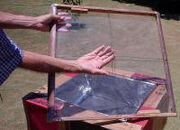
Wires are attached in a crosswise fashion
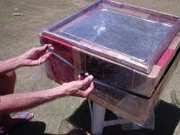
while a rubber tube seals against air loss
- March 2006: Enthusiastic new solar promoter Jose Albano (see Solar Cooking Archive informs, inspires Brazilian promoter, has developed an interesting solar box cooker lid system that creates a double-paned plastic window effect and stops air loss through the lid/cooker joint. Mr. Albano notes that this idea works best in areas near the equator, where the sun is often directly overhead and reflectors are not required. The system can be used with cookers made from various materials, including cardboard and wood. The first step is to build a four-sided lid frame using wooden boards about one-inch thick. Next, tautly attach wires in a crosswise fashion on both sides of the wooden frame, creating a “skeleton” that will serve to separate two layers of plastic sheeting and allow for insulating air space between them. Spread a sheet of transparent plastic across one side of the frame, wrap the ends around to the opposite side of each board, and secure with staples. After food has been placed in the cooker, place the lid on top of the four walls of the cooker with the plastic side down. A larger sheet of transparent plastic is then draped over the lid partway down all four sides of the cooker. This sheet is secured using a rubber tube or similar fastener, preventing air from escaping. [Editor’s note: Solar Cookers International recommends polypropylene, polyester or polycarbonate plastic sheeting.]
- July 2005: Professor Arnaldo Moura Bezerra reports that the small city of Uirauna, in the "backwoods" of the state of Paraiba, boasts its own solar cooker production unit. A priest known as Father Domingues manages production of parabolic cookers based on the SK-14 cookers developed by EG-Solar of Germany. Residents use the cookers daily. Contact Arnaldo Moura Bezerra by e-mail: mourabezerra@uol.com.br

